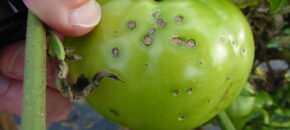The hot, then windy, then wet weather these past few weeks have brought with it prolonged windy days and rain to many areas. In general, this type of weather is ideal for the development and spread of many vegetable diseases. By now most growers are on weekly protectant fungicide programs to help prevent disease development. […]
Continue reading...Preparing for important fungal diseases in Asparagus during the summer.
Asparagus growers should consider scouting their fields during the summer months for foliar disease development. Important pathogens that growers need to scout for on a regular basis include Purple spot, Cercospora, and Rust.
Continue reading...Diagnosing Important Diseases In Tomato – Reference Guide

The following images consist of important diseases in tomato. These images can be used as a quick reference for diagnosing important fungal and bacterial pathogens. For best results, please turn your device (i.e., cell phone) sideways. For information on commercial control recommendations, please visit the tomato section of the 2022/2023 Mid-Atlantic Commercial Vegetable Production Guide. […]
Continue reading...Organic Production: Suppressing Soil-borne Pathogens in 2022
Pathogens such as Fusarium, Pythium, Phytophthora, Thielaviopsis and Rhizoctonia that cause pre- and post-emergent damping-off can cause serious problems in organic (and conventional) production. The key to controlling and/or suppressing damping-off pathogens with biological controls is keeping the biological populations high and continually present on root surfaces of the host, and by following good cultural […]
Continue reading...Quick reviews of fungicide chemistries, FRAC groups, and fungicide resistance management
For a quick review on fungicides, FRAC groups, and managing fungicide resistance development please click on the links below. Using tank mixes and fungicide rotations and information on FRAC group 4, FRAC group 7, and FRAC group 3 and FRAC group 11 fungicides.
Continue reading...Preparing for cucurbit downy mildew in 2023
In 2004, cucurbit downy mildew re-emerged in the US with a vengeance causing significant losses in cucurbit production. In most years prior to this, concern for CDM control was minimal, since the pathogen arrived late in the growing season (in more northern regions), or the pathogen caused little damage, or never appeared. After 2004, with […]
Continue reading...